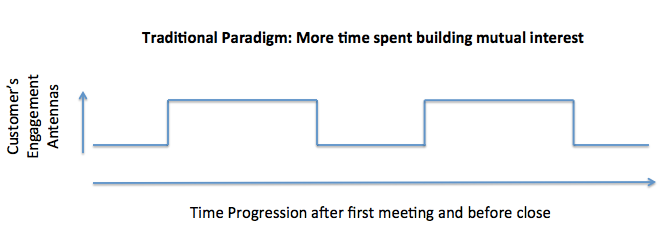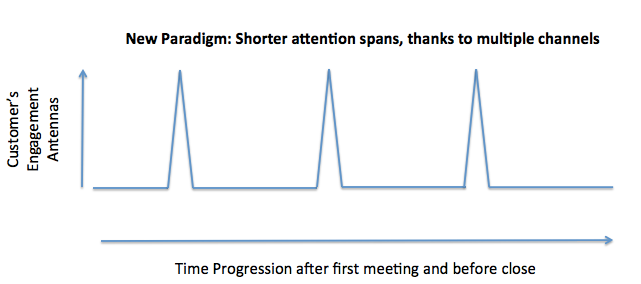The Art Of Keeping In Touch With Customers: How To Increase ROI Using Social Selling Tools
I recently met with a young entrepreneur who was in search for some words of wisdom on sales. His B2B business had long cycle time (time spent from prospecting to close). I shared with him that a lot of sales is common sense, then asked him, “When it comes to sales process, what comes to your mind?” He collected his thoughts and said, “Given that my business is targeted towards a small crowd, I would make a list of these targets. Then, I will reach out to those whom I can find a referral. After that, meet them, build a relationship, close the deal and follow through.”
I probed him further, “How would you build relationships?” He said, “By sharing our common interest during the first meeting.” His product is a very expensive next generation toy, and his targeted prospects would likely share a passion for the same. They would entertain a first meeting. I could easily see how he could build rapport. I chimed in, “Ok, that makes sense, but how do you plan to keep in touch after the first meeting?” He was enjoying the thinking challenge. He said, “I will send him/her updates as we develop the product.” I countered, “If your updates are all about you and your products, how can you sustain the conversation over several months? You run the risk that prospective customers would press the reject buzzer that we hear in TV talent shows.”
He pondered, “You make an interesting point. I need to think about that.”
I pulled out a napkin, and drew two charts. The first one is how sales folks engage with customers from days of yore - this traditional paradigm still works. See diagram below. Sales folks spend time with the decision makers playing golf periodically, visiting them personally when they are in town etc. They spend more time in person building customer’s engagement antennas.
In today’s world, given the multitude of informational sources, attention spans are challenged and most interactions are like a pulse (diagram below) – a spike in attention that interests them and they quickly move on to the next. In the daily grind of things, the reality is somewhere in between the two graphs.
As my entrepreneur friend was examining the charts, I shared with him two pulse like experiences, way before social selling became known.
A friend of mine got promoted to a senior position in 2004. Soon, he got a call from a wealth portfolio manager. My friend was curious how he ended up on the wealth portfolio manager‘s radar. The portfolio manager shared that he recently read in a magazine about my friend’s promotion and that prompted him to reach out. My friend enjoyed the thoughtfulness of the caller and was pleasantly surprised.
The second experience is with a candidate who interviewed for a position. This happened in 2006, he made a good impression during the interview and he was one of the runner-ups. I was surprised to see an email from him, few months later with a note about my alma mater winning a key game in college football. I was impressed with his attention to small detail – we briefly talked about universities during his interview. Even after many years, I can vividly recall as the candidate’s tenacity shone through. He stood out for finding personal ways to keep in touch.
When I shared the two stories with my millennial entrepreneur and asked him “What do you think?” He quickly added, “I like them, we can easily replicate this approach in this digital age very efficiently through numerous outlets.
- Google Alerts
- LinkedIn’s Keep in Touch feature that showcases birthdays, job changes, promotions and work anniversaries. A daily routine visit to LinkedIn “Connections” tab, followed by “Keep in Touch” sub tab highlights folks in my network with these trigger events.
- LinkedIn’s Company Update Alerts feature. By following companies on LinkedIn, it can trigger updates on my LinkedIn feed whenever the company posts updates.
I can leverage these tools to cull out personal and professional drivers of my prospects. At the very least, I will know what to look for during my first conversation! And use their context when I touch base with them".
The beauty of being a coach is that solutions emanate from the person who is coached. Hearing the words, I felt like a happy coach. As we were wrapping up our coffee meet, I shared, “Do you know the best kept secret of sales about keeping in touch?” He smiled and said, “Why don’t you answer this one, instead of drawing it out of me?” I chuckled, “All the keep in touch approaches you discussed can increase your ROI. There is one, when used judiciously can bloom relationships to great heights. Once in a while, reach out to your contact without any reason. Sometimes, the best excuse to call is your thoughtfulness for the person. For other times, you still have the social tools for finding a good context to keep in touch".
Summary
Long sales cycle brings out one challenge that is real but rarely touched upon – good reasons to keep in touch that is in contextually relevant to the customer. Many times, it is the simple thoughtfulness on small details that propel success. During the days of yore, sales people had to keep manual records of reasons for keeping in touch with customers. In this day and age, “Keep in Touch” and Company page alerts features in LinkedIn provide social selling tools. Leverage them to increase your sales ROI and enjoy your success in this digital age.
To learn more social selling best practices, subscribe to the LinkedIn Sales Blog.
Topics: Sales strategy
Related articles






